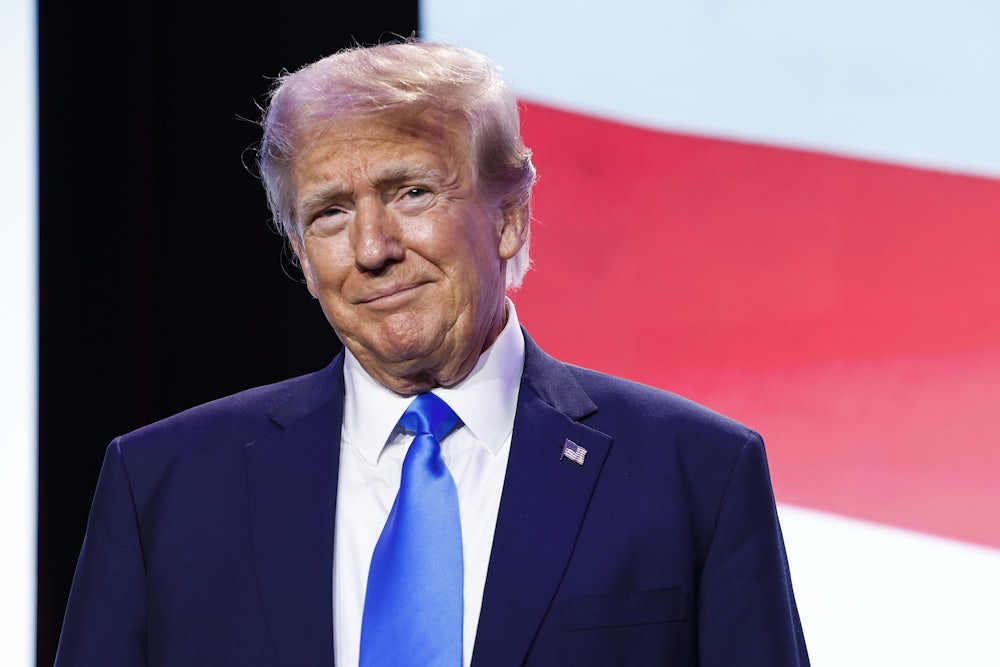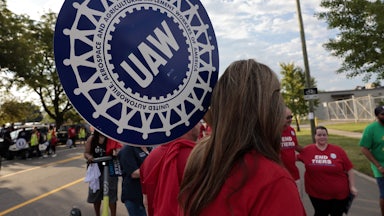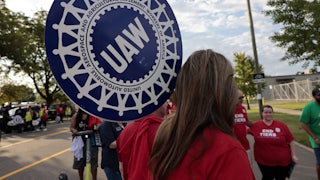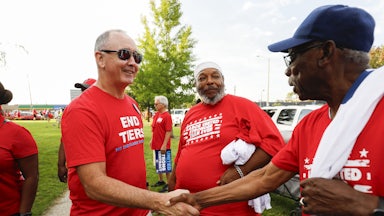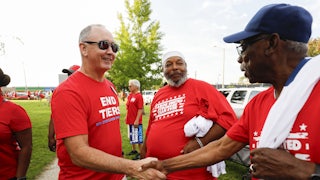Future historians will puzzle over how Donald Trump could have won strong working-class support while consistently undermining organized labor. But why wait? I puzzle over this riddle in real time.
Even before, as president, Trump dismantled health and safety protections and labor rights for workers and slashed taxes for corporations and the rich, he admitted in a televised primary debate that he thought wages were “too high.” Trump later clarified that he meant the federal hourly minimum wage. Then Trump said there should be no federal minimum wage. Then Trump said, OK, let’s keep the federal minimum wage and raise it to $10. Then, as president, Trump made not the slightest effort to raise the minimum wage, which remains the same miserly $7.25 an hour.
Trump’s anti-worker stance as president cost him only a single percentage point’s support among working-class voters (defined as voters lacking a college degree), from 51 percent in 2016 to 50 percent in 2020. That’s basically a rounding error. More worrying still, Trump’s share of nonwhite working-class voters rose from 20 percent in 2016 to 26 percent in 2020. Harold Meyerson wrote in The Washington Post after the 2016 election that an unnamed “union staff member” told him it was “an extinction-level event for American labor.” It wasn’t, but it came too close for comfort.
The United Auto Workers strike is receiving extremely favorable press at a time when public support for labor unions is higher than it’s been since the liberal hour of the Great Society. That makes it an opportunity for a self-styled populist like Trump to make peace with organized labor. On NBC News’s Meet the Press Sunday, Trump declined. UAW President Shawn Fain, Trump said,
is not doing a very good job in representing his union, because he’s not gonna have a union in three years from now. Those jobs are all gonna be gone because all those electric cars are gonna be made in China.
For years Trump’s line on organized labor has been: I love the working man and I have no particular beef with unions, but union leaders always work against their members’ interests. In 2018, for instance, Trump tweeted in response to some barbs from then-AFL-CIO President Richard Trumka: “Some of the things he said were so against the working men and women of our country, and the success of the U.S. itself, that it is easy to see why unions are doing so poorly.” Love me, Trump tells the working class, and loathe anybody who would presume to represent your collective interests (unless of course they happen to endorse Trump, which they almost never do).
Trump’s knock against Inflation Reduction Act spending to promote electric cars builds on a video statement Trump released in July, seeking a UAW endorsement that he’s never going to get. In that video Trump said, “Joe Biden is waging war on the U.S. auto industry with a series of crippling mandates designed to force Americans into expensive electric cars.” Climate policy is the enemy.
Apparently that didn’t work, so Trump is now resorting to wholesale fabrication. Now he says that the IRA showers electric car subsidies on China. As TNR’s Kate Aronoff pointed out last week after Senator J.D. Vance, Republican of Ohio, test-drove this whopper, that’s pretty much the opposite of what the IRA does. The IRA subsidizes electric car production not in China but here in the United States. I quote Aronoff at some length because the details are important:
IRA incentives for electrification are hyper-focused on excluding products from China and any other “foreign entity of concern” and enriching domestic automakers by reshoring production in the U.S. In order for plug-ins to qualify for the IRA’s $7,500 consumer rebate, they need to be assembled in the U.S. Forty percent of the minerals used to power their batteries need to be sourced from the U.S. or from a country with which it has a free trade agreement. Fifty percent of battery components need to meet the same criteria. Each of those requirements ramps up by 10 percent every year.
Far from going to China, the IRA’s clean energy subsidies are flowing disproportionately and, very ironically, to Republican congressional districts. The UAW’s beef with Biden isn’t that Biden’s subsidizing the transition to electric cars but rather that Biden isn’t targeting these subsidies sufficiently to union shops. In particular, Fain wants subsidized battery manufacturing, which replaces power-train assembly that automakers used to perform in-house, to conform to a UAW-negotiated contract. Trump would never sign on to that in a million years.
Can Republicans gain traction blaming autoworkers’ problems on mythical Biden administration subsidies to China, even as (as Aronoff noted) Biden’s kept in place a steep 27.5 percent tariff that Trump imposed on Chinese-made cars? Saul Anuzis, former chairman of the Michigan Republican Party, says yes. “This might be that crisis,” he told Politico, “that takes a lot of blue-collar, working-class Americans to sit there and say, ‘We’re getting shafted by these left-wing policies that are really not very practical.’”
This sounds to me like a fantasy, especially as it relates to Michigan. As Politico’s Myah Ward and Ally Mutnick pointed out, in 2020, Biden won the state and Democrats won back the statehouse and the governorship. The state Republican Party is broke, and the GOP hasn’t won a Senate seat for 19 years.
On the other hand, the Democratic share even of the union household vote—the one working-class demographic where Democrats reliably maintain an edge—has mostly fallen over the past 20 years. Biden broke this pattern by expanding Hillary Clinton’s union-household advantage of eight percentage points in 2016 to 16 percentage points in 2020, bringing labor support back in line with where it stood under Obama. But in 1992, Bill Clinton (who was much less pro-union than Biden) won union households by no fewer than 31 percentage points. Clinton also won that year a 44 percent plurality of working-class voters—13 percentage points more than George H.W. Bush and 19 percentage points more than Ross Perot. Times have changed!
Why does the working class no longer support the party of working men and women? Well, obviously the decline of organized labor plays a huge role; the proportion of private-sector workers represented by a union is 6 percent, about half what it was in 1992. But Lainey Newman, a law student at Harvard, and the Harvard sociologist Theda Skocpol suggest in their new book, Rust Belt Union Blues, that the decline shouldn’t be measured just in terms of falling membership. It should also be measured according to unions’ presence in the rank and file’s everyday nonworking lives.
Through fieldwork Newman conducted in Western Pennsylvania, the book documents the community-building role that union halls and labor-affiliated churches formerly played but mostly play no longer. Some of this was practical, like the sponsorship of blood drives and Alcoholics Anonymous chapters. Some was purely recreational, like fishing clubs, coin-collectors’ clubs, golf field days, and yes, that favorite of Harvard political scientist Robert D. Putnam, bowling leagues.
The thesis of Putnam’s book Bowling Alone, which created a sensation when it was published in 2000, was that the decline of fraternal and other volunteer and recreational organizations left Americans feeling isolated and mutually distrustful. That certainly fits what Newman and Skocpol describe. But it’s also more complicated than that. In many cases, the communities themselves simply vanished as industrial plants shut down. The ones that remained were no longer close by; workers had to travel long distances to get to work. Skocpol, who grew up south of Detroit, told me she’d recently been back and noticed that while Ford’s massive River Rouge plant in Dearborn was still in business, the smaller auto plants further south along the river, around which thriving communities had formed, were mostly gone. Today autoworkers, she said, “are driving in.”
The other way it’s more complicated is that, although people stopped bowling in leagues, that doesn’t mean they kept to themselves. Often they just exchanged one affinity group for another. We are, after all, social creatures. In the case of unions, the affinity groups that filled the breach, Newman and Skocpol argue, were gun clubs and NRA chapters and Tea Party groups. As a consequence, union members’ political orientations changed. Different affinity group, different affinity.
Sometimes, they write, the affinity group was an extremist election-denying group like the Proud Boys and the Oath Keepers:
The founder of the Proud Boys, Gavin McInnes, explained on his podcast … that the Proud Boys began as a “drinking club” in which like-minded men would meet at bars in New York City and gripe about politics and social progress.… Proud Boys meetings … were quite like those that “the Shriners or the Elks might do.”
You hear much the same about Islamist terrorists. Max Abrams, a political scientist at Northeastern, wrote a memorable paper in 2008 titled “What Terrorists Really Want.” Its conclusion was that it had very little to do with 72 virgins in paradise; what these lost young men sought was to “develop strong affective ties with fellow terrorists.” Summarizing this and similar studies in a 2009 Slate piece, I reached for the same comparison as McInnes: “Think the Elks, only more lethal.”
Some unions maintained their affinity-group role better than others. The International Brotherhood of Electrical Workers, Newman and Skocpol write, did a better job staying up close and personal than the United Steelworkers, probably reflecting the electricians’ more secure economic position and the temporary nature of their work assignments. Unlike Steelworkers, electricians migrate from from job to job, so they’re much less vulnerable to abrupt local shocks like a plant closing.
“I haven’t thought through how you compare the UAW’s trajectory,” Skocpol told me. One survey the book cites says the UAW remained more loyal to the Democratic Party than other unions, possibly because the survey was conducted not long after the Obama administration bailed out GM and Chrysler. Another reason, Skocpol told me, may be that the UAW has more African American members than other industrial unions.
What seems clear from reading Newman and Skocpol is that labor unions must put more effort into community building where that’s still possible. Tom Lewandowski was doing this sort of work in New Haven, Indiana, as president of the Northeast Indiana Central Labor Council until the AFL-CIO shut the council down as part of a restructuring. Lewandowski then kept the project going on a shoestring budget with no union affiliation under the name the Worker’s Project. My friend the late writer Barbara Ehrenreich put me in touch with Lewandowski about six years ago, and the three of us met for lunch in Alexandria, Virginia. At the time I was editor of a paywalled section of Politico on labor policy.
At lunch, Lewandowski bemoaned the unions’ loss of interest in preserving their community-building role. I’m sorry to report that I didn’t quite get it. “Tell him about the softball picnic,” Barbara told Lewandowski, and Lewandowski explained that he’d sponsored a softball picnic that drew a big crowd. I thought: What can a softball picnic do to boost stagnant wages? And why was Barbara, the tough-minded author of Nickel and Dimed and Fear of Falling, buying into this gauzy nonsense?
My lunch with Lewandowski put me in mind of “Il faut cultiver notre jardin,” the famous concluding line from Voltaire’s Candide. What did that even mean? I didn’t understand in Madame Laidig’s eleventh-grade high school French class, and I didn’t understand sitting across from Lewandowski. I listened politely, went back to my office, and forgot all about the Worker’s Project.
Now, having read Newman and Skocpol, I think Lewandowski was right and I was just too clueless to understand. Among the other difficult tasks labor faces, it must cultivate its garden. When it doesn’t, all sorts of MAGA weeds take root.
